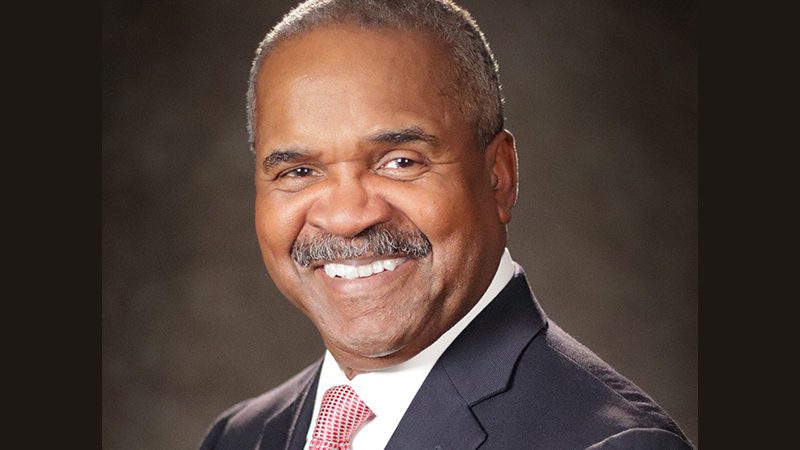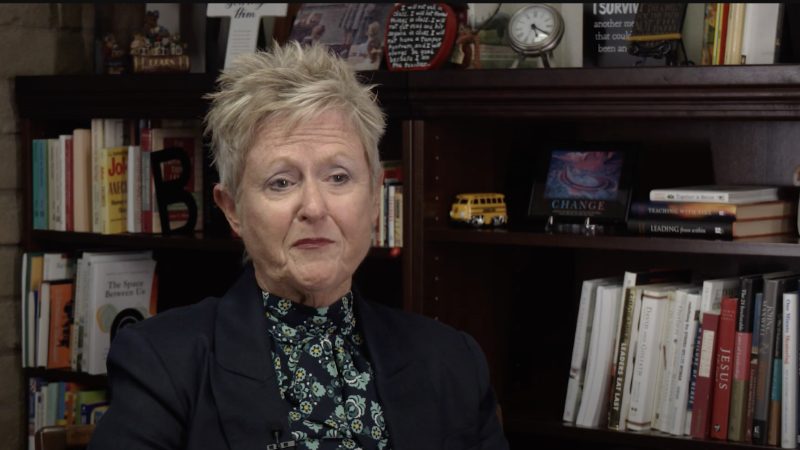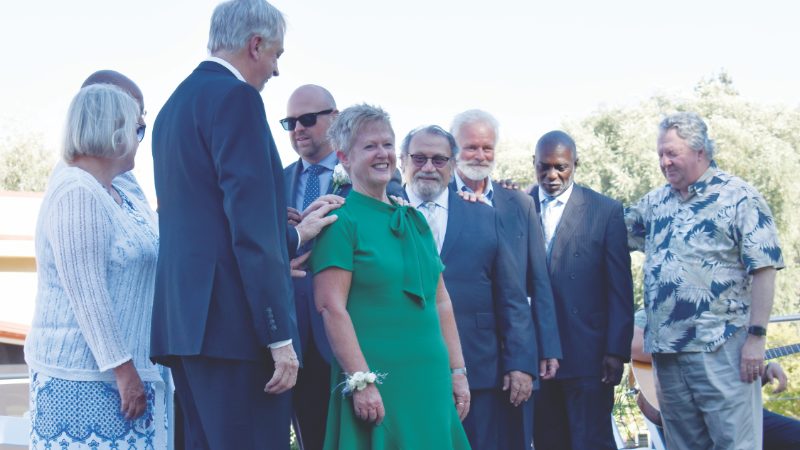When Jennifer and I visit our two granddaughters in Sonora, California, there is excitement when we exit the car in the driveway. Two little voices call out our names (“Jaja and Papa!”) and their little arms wrap around our legs. The next question is directed to Jennifer, “Jaja, did you bring crafts?” It is a scene of joy. But after a few days, the inevitable comes. We must say goodbye. “Can’t you stay longer?” With hugs and kisses, we tell them that we will see them again when they visit our house. We miss each other until we are together again.
This scene, familiar to other families at front doors, airports, and train stations, is told in the Gospel of John, chapters 13-16. Jesus and His twelve (soon to be eleven) disciples have shared the Last Supper, and Jesus has imparted His final teachings before the Cross. He closes with these words in John 16:33, “In the world you will have tribulation; but be of good cheer, I have overcome the world.”1
It is then that we encounter a treasure of the Gospels, recorded only by John. It is Jesus’ prayer. Not the Lord’s Prayer that we are so familiar with—it is the personal prayer of Jesus to His Father. Thousands of these prayers had been offered by Jesus over His 33 years of life. They remain unknown to history. Yet this is one for the ages. Here is the meeting of God’s Son and His Father on the cusp of the great controversy’s great battle—will the Son of God fulfill His prophetic destiny to die for the rebellion of Adam’s race? The Garden struggle later that evening is just ahead. The agonizing pain of the Roman crucifixion is coming. Worst of all is the anticipated complete separation of Jesus from His Father when He cries, “My God, my God, why have you forsaken me?”
Jesus’ prayer in John 17 is divided into three sections as He prays for Himself, then for the disciples, and then—wonder of wonders!—for you and me. This prayer is worthy of many pages of commentary and much prayerful reflection. Here our Lord entreats His Father that “the love with which You loved Me may be in them” (John 17:26). Jesus, the Word made flesh, prays, “Sanctify them by Your truth. Your word is truth” (verse 17). As He reflects upon His ministry of three years, the Savior declares, “This is eternal life, that they may know You, the only true God, and Jesus Christ whom You have sent” (verse 3). It is this specific declaration that speaks powerfully to us, His modern disciples, who are called to share the good news.

Last year the “2020 Religious Census: Religious Congregations and Adherents Study” was published.2 It examines the level of presence by 374 religious bodies county by county in the United States. Rather than counting individual believers, it focuses on the formal gatherings of these groups. Seventh-day Adventists were included in the data: our congregations are present in 57% (1,805) of the counties across the country, we have a larger than average presence in large metropolitan areas, and there is an interesting map showing our presence in relation to the total population. Of particular interest was the high density of our congregations versus population on the West Coast of the nation. The data reveals to me that Jesus’ prayer in John 17 is being answered yet also remains largely unfulfilled.
The Apostle John records the post-resurrection encounter with Jesus and His disciples and inserts his own comment, “But these are written that you may believe that Jesus is the Christ, the Son of God, and that believing you may have life in His name” (John 20:31). Are we giving people in our cities, towns, and counties that wonderful invitation to believe and have life in Jesus? Certainly, this remains at the very core and purpose of what it means to be a Seventh-day Adventist today. We are called upon to represent the true character of God and in so doing issue the invitation to the welcoming kingdom of Christ. But can we do more?

Recently, the Pacific Union Conference Executive Committee voted to place a special emphasis on the work of outreach evangelism in 2025, adopting the theme “Sharing Jesus.” Without a doubt, our churches and schools—pastors, teachers, and members in our churches—are engaged in mission outreach every week in every year. Yet giving a special emphasis in 2025 provides an additional opportunity to reflect together on how we can more effectively be engaged in this essential calling as God’s church in the world.
One of the ways that the Pacific Union Conference will be supporting this effort will be through extra financial support to each of our seven local conferences. An additional $1.3 million above the regular annual evangelism appropriations to these fields will be given in 2025. This will be designated as direct support for our local churches and schools as they find new and creative ways to be the welcoming kingdom of Christ in their communities. If you are interested in finding out how your church or school can participate, contact your conference officers for further information. Right now, planning is underway throughout the Pacific Union for training and inspirational events to support the “Sharing Jesus” activities in your community.
None of this will have any lasting effect unless we bring our plans before the Lord in prayer. Please join me each day in praying for the outpouring of the Holy Spirit as we look to 2025 and beyond. There are so many people who are longing for the answers that only Jesus can give. Our Lord’s invitation comes to us all: “The harvest truly is great, but the laborers are few; therefore pray the Lord of the harvest to send out laborers into His harvest” (Luke 10:2).
_____________________________
Bradford C. Newton is the president of the Pacific Union Conference.
1 Unless otherwise indicated, all Scripture quotations are from the New King James Version.
2 https://www.usreligioncensus.org/
El reino acogedor
Por Bradford C. Newton
Cuando Jennifer, mi esposa, y yo visitamos a nuestras dos nietas en Sonora, California, hay emoción cuando salimos del auto en la entrada de su casa. Dos vocecitas gritan nuestros nombres («¡Yaya y Papa!») y sus bracitos abrazan nuestras piernas. La siguiente pregunta está dirigida a Jennifer: «Yaya, ¿trajiste artesanías?» Es una escena alegre. Pero al cabo de unos días, llega lo inevitable. Hay que decir adiós. «¿No pueden quedarse más?» Con abrazos y besos les decimos que los volveremos a ver cuando visiten nuestra casa. Nos echamos de menos hasta que volvemos a estar juntos.
Esa escena, familiar para otras familias en las puertas, aeropuertos y estaciones de tren, se cuenta en el Evangelio de Juan, capítulos 13-16. Jesús y sus doce discípulos (que pronto serían once) habían compartido la Última Cena, y Jesús les había impartido sus últimas enseñanzas antes de la cruz. Termina con estas palabras en Juan 16:33: «En el mundo tendrén tribulación; pero tengan ánimo, yo he vencido al mundo».
Es entonces cuando nos encontramos con un tesoro de los evangelios, registrado solo por Juan. Es la oración de Jesús. No es el Padre Nuestro con el que estamos tan familiarizados, es la oración personal de Jesús a su Padre. Miles de esas oraciones habían sido ofrecidas por Jesús a lo largo de sus 33 años de vida. Siguen siendo desconocidas en la historia. Sin embargo, esa es una para los siglos. Aquí está el encuentro del Hijo de Dios y su Padre en la cúspide de la gran batalla del gran conflicto: ¿cumplirá el Hijo de Dios su destino profético de morir por la rebelión de la raza de Adán? La lucha en el Jardín más tarde esa noche está a punto de llegar. El dolor agonizante de la crucifixión romana está a la puerta. Lo peor de todo es la anticipada separación completa de Jesús de su Padre cuando clama: «Dios mío, Dios mío, ¿por qué me has abandonado?»
La oración de Jesús en Juan 17 se divide en tres secciones, ya que ora por sí mismo, luego por sus discípulos, y después, ¡maravilla de maravillas!, por ti y por mí. Esa oración es digna de muchas páginas de comentarios y mucha reflexión en oración. Aquí nuestro Señor ruega a su Padre que «el amor con que me has amado esté en ellos» (Juan 17:26). Jesús, el Verbo hecho carne, ora: «Santifícalos con tu verdad. Tu palabra es verdad» (v. 17). Al reflexionar sobre los tres años de su ministerio, el Salvador declara: «Esta es la vida eterna: que te conozcan a ti, el único Dios verdadero, y a Jesucristo, a quien has enviado» (v. 3). Es esa declaración específica la que nos habla poderosamente, sus discípulos modernos, que estamos llamados a compartir las buenas nuevas.

El año pasado se publicó el «Censo Religioso 2020: Estudio de Congregaciones Religiosas y Adherentes».1 Examina el nivel de presencia de 374 organismos religiosos condado por condado en los Estados Unidos. En lugar de contar a los creyentes individuales, se centra en las reuniones formales de esos grupos. Los adventistas del séptimo día fueron incluidos en los datos: nuestras congregaciones están presentes en el 57% (1.805) de los condados del país, tenemos una presencia mayor que el promedio en las grandes áreas metropolitanas, y hay un mapa interesante que muestra nuestra presencia en relación con la población total. De particular interés es la alta densidad de nuestras congregaciones en comparación con la población de la costa oeste de la nación. Los datos me revelan que la oración de Jesús en Juan 17 está siendo contestada, pero también sigue sin cumplirse en gran medida.
El apóstol Juan registra el encuentro posterior a la resurrección de Jesús con sus discípulos e inserta su propio comentario: «Pero estas cosas se han escrito para que crean que Jesús es el Cristo, el Hijo de Dios, y para que, creyendo, tengan vida en su nombre» (Juan 20:31). ¿Estamos dando a las personas en nuestras ciudades, poblaciones y condados esa maravillosa invitación a creer y tener vida en Jesús? Ciertamente, eso sigue siendo el núcleo y el propósito de lo que significa ser un adventista del séptimo día. Estamos llamados a representar el verdadero carácter de Dios y, al hacerlo, hacer una invitación al acogedor reino de Cristo. Pero ¿podemos hacer más?

Recientemente, el Comité Ejecutivo de la Pacific Union Conference votó poner un énfasis especial en la labor de evangelización en 2025, adoptando el lema «Compartiendo a Jesús». Sin lugar a duda, nuestras iglesias y escuelas, pastores, maestros y miembros de iglesia, participan en la obra misionera cada semana de cada año. Sin embargo, dar un énfasis especial en 2025 brinda una oportunidad adicional para reflexionar sobre cómo podemos participar de manera más efectiva en ese llamado esencial como iglesia de Dios al mundo.
Una de las formas como la Pacific Union Conference apoyará ese esfuerzo será a través de apoyo financiero adicional a cada una de nuestras siete conferencias. En 2025 se otorgarán $1.3 millones adicionales además de las asignaciones anuales regulares de evangelismo. Eso se designará como apoyo directo para nuestras iglesias y escuelas a medida que encuentran formas novedosas y creativas de ser el acogedor reino de Cristo en sus comunidades. Si está interesado en saber cómo su iglesia o escuela puede participar, comuníquese con los oficiales de su conferencia para obtener más información. En este momento, se están planificando en toda la Pacific Union eventos de capacitación e inspiración para apoyar las actividades de «Compartiendo a Jesús».
Nada de eso tendrá ningún efecto duradero a menos que llevemos nuestros planes ante el Señor en oración. Por favor, únanse a mí cada día en oración por el derramamiento del Espíritu Santo mientras miramos hacia 2025 y más allá. Hay muchas personas que anhelan las respuestas que solo Jesús les puede dar. La invitación de nuestro Señor nos llega a todos: «La mies es verdaderamente mucha, pero los obreros son pocos; por tanto, rueguen al Señor de la mies que envíe obreros a su mies» (Lucas 10:2).
_____________________________
Bradford C. Newton es el presidente de la Pacific Union Conference.
1 https://www.usreligioncensus.org/






